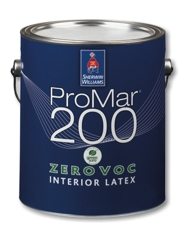As a professional painter, your environmental footprint is much larger then you probably realize. As opposed to other professions, painters create significantly more waste, travel for every job, and require some non-recyclable materials. While this is the unfortunate truth, there are steps you can take to be more environmentally friendly. Many consumers are conscious about the environment and showing a commitment to their concerns will bring more business while doing your part.
Start with Eco-Friendly products
 Understanding what’s in the paint you use is the very first step to being an eco-friendly painter. Many commercial paints contain large amounts of VOCs (volatile organic compounds), which are bad for the planet, the painter, and your customer. Stick with all-natural or plant-based paints with low or zero VOCs. Even if they are slightly more expensive there will be less toxic odor and a better experience for your client. Often times a house is painted after the current residents have moved out and may be sitting empty for weeks. This is not an excuse to use high VOC paint as the dangerous gasses will stick around.
Understanding what’s in the paint you use is the very first step to being an eco-friendly painter. Many commercial paints contain large amounts of VOCs (volatile organic compounds), which are bad for the planet, the painter, and your customer. Stick with all-natural or plant-based paints with low or zero VOCs. Even if they are slightly more expensive there will be less toxic odor and a better experience for your client. Often times a house is painted after the current residents have moved out and may be sitting empty for weeks. This is not an excuse to use high VOC paint as the dangerous gasses will stick around.
When searching for environmentally friendly brushes look for ones that are made from recycled material. The brush itself, the handle, and all small components can be created from recycled materials and there are many in the market. Using recycled brushes produces a significant and immediate affect on the amount of waste you are personally producing.
Use sustainable techniques
Using a paint that holds well over time is not just best for your customer, its best for the earth as well. Every time a house needs to be painted it creates trash and pollution. As a professional painter, you know through experimentation what methods work best. Making a commitment to use only these techniques goes a long way.
Along these same lines, don’t be afraid to give a small amount of paint to your customers after you finish the project. A small amount works perfect if touch-ups become necessary. This way, the customer will never have to waste time or money going to the store to buy a small amount of paint and probably end up with far too much leftover.
Reuse, Reuse, Reuse
Every tool you have should be reused as much as possible. A tarp is good as long as it has 0 holes in it and although to some it may appear messy, when you explain your commitment to reducing waste customers totally understand. When it comes to brushes these are obviously used for as long as possible but try even further extending the life of your brushes by caring for them rather then replacing them as necessary. Lastly, with leftover paint you should always find a use for it. Some like taking their paint to local paint swaps, others mix all the leftovers to create a unique color. Either way, paint should never be thrown away intentionally.
When the time finally comes for you to dispose of all your leftover materials, have them picked up by a junk collecting professional that employs landfill diversion tactics. This way even when you are deciding something is waste there is another opportunity for it to be repurposed or recycled.
On top of these tips, try to take the most economical route from job to job. These tips will not only cut down your environmental footprint, but will also cut down your expenditures if applied correctly. The painters over at Wow 1 Day Painting have enjoyed success in branding themselves as an eco-friendly painting service and their customers love that they do not have to come home to strong odors or dangerous fumes.
What steps have you taken to be eco friendly, leave a comment below and let us know!

We love this article! These are great tips for being eco-friendly while on the job.
Thanks! Have you got any other suggestions for being eco friendly?
@Sherwin-Williams Im glad you like my article! I’d also love to hear any more tips you have!